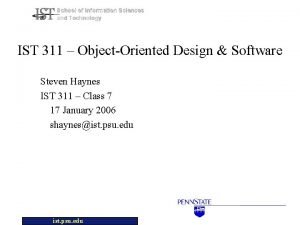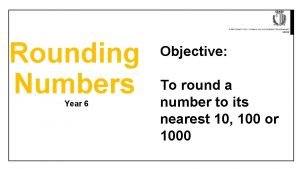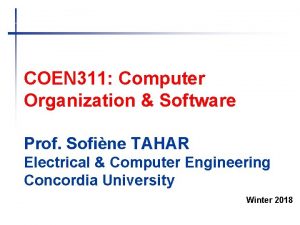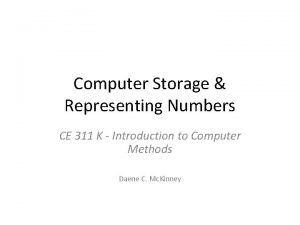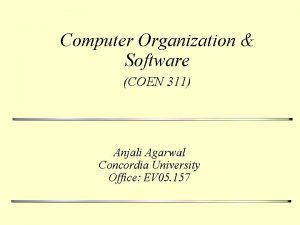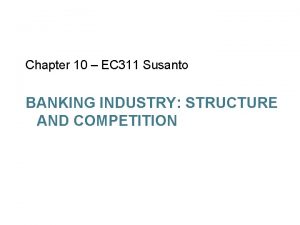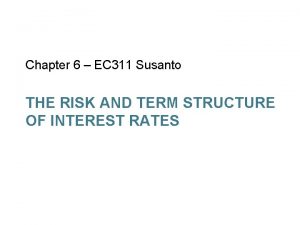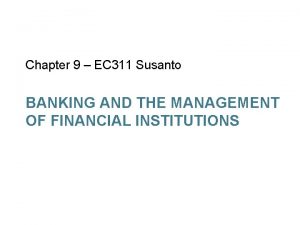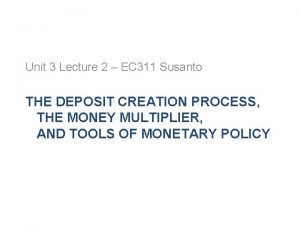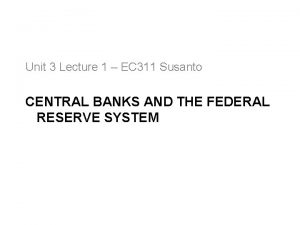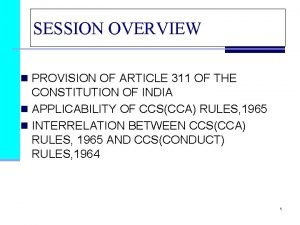Chapter 2 EC 311 Susanto OVERVIEW OF THE
























- Slides: 24

Chapter 2 – EC 311 Susanto OVERVIEW OF THE FINANCIAL SYSTEM * ALSO AVAILABLE TO DOWNLOAD: CHAPTER NOTES FROM EC 311. WEEBLY. COM

Some definitions (Refer to Chapter Notes for more details) • Assets: anything of durable value that acts as a means to store value over time. – Real assets are assets in physical form. – Financial assets are claims against real assets. • Financial market: where financial assets are traded. – Could be newly issued or previously issued fin. Assets. • Financial institution: an institution whose primary source of profits is through financial asset transactions. 2 -2

More terms • To “finance”: to raise money in order to make some big purchase. – Issuing new stock is called equity financing. – Bond financing (formal IOU): selling bonds to people and institutions paying a fixed amount of interest at regular intervals, and repaying the original amount (the "principal") at the end of some fixed term. – More than 90% of the external funds of American businesses are raised by borrowing. • ”Financial" basically means "pertaining to money or credit. " • For every real transaction, there is a financial transaction that mirrors it. 2 -3

Function of Financial Markets 1. Allows transfers of funds from persons or businesses without investment opportunities to one who has them (from “lenders/savers” to “borrowers/spenders”) 2. Improves economic efficiency Financial markets are critical for producing an efficient allocation of capital, allowing funds to move from people who lack productive investment opportunities to people who have them. It also improve the well-being of consumers, allowing them to time their purchases better. 2 -4

Financial Markets: • Financial instruments: claims on the borrower’s future income or assets. – Direct finance: through securities (IOU’s). – Indirect: involves intermediaries. • Securities: exchangeable form of financial assets. – Financial asset: any financial claim or piece of property that can be owned; has no intrinsic value. – Financial liability: the obligation that the issuer of an asset has to the buyer of that asset. • Financial intermediaries help increase efficiency by decreasing transaction (search) costs. 2 -5

Function of Financial Markets 2 -6

First Way to Classify Financial Markets 1. Debt Markets Short-term (maturity < 1 year) Money Market Long-term (maturity > 10 year) Capital Market Intermediate-term (maturity in between) 2. Equity Markets Common stocks Pay dividends, in theory forever Represents an ownership claim in the firm * Refer to class notes for details on the difference between (and examples of) money market and capital market 2 -7

Second Way to Classify Financial Markets 1. Primary Market New security issues sold to initial buyers Typically involves an investment bank who underwrites the offering 2. Secondary Market Securities previously issued are bought and sold Examples include the NYSE and Nasdaq Involves both brokers and dealers – Broker: executes trades on behalf of other – Dealer: buys and sells securities on his own account 2 -8

Third Way to Classify Financial Markets 1. Auction Markets: “Centralized facility” by which buyers and sellers, through their brokers, execute trades in an open and competitive bidding process. 2. Over-the-Counter Markets: Has no centralized mechanism or facility for trading, through dealers 3. Organized Exchanges: Centralized like auction markets, but securities are traded through specialist traders who combine broker and dealer functions (e. g. , NYSE). 4. Intermediation financial markets: conducted through financial intermediaries. 2 -9

Internationalization of Financial Markets • International Bond Market 1. Foreign bonds – of a foreign entity denominated in home currency (German producer issues in US in $) 2. Eurobonds – denominated in foreign currency (in £ in the US) Now larger than U. S. corporate bond market • World Stock Markets The trend is internationalization; U. S. stock markets are no longer the largest. • Eurocurrencies Foreign currency deposited outside of home country Eurodollars are U. S. dollars deposited, say, London. Gives U. S. borrows an alternative source for dollars. 2 -10

Relative Decline of U. S. Capital Markets Why? 1. New technology in foreign exchanges 2. 9 -11 made U. S. regulations tighter 3. Greater risk of lawsuit in the U. S. 4. Sarbanes-Oxley has increased the cost of being a U. S. -listed public company This is even before the worldwide financial crisis that started in 2008!! 2 -11

Functions of Financial Intermediaries 1. Engage in process of indirect finance 2. More important source of finance than securities markets 3. Needed because of transactions costs and asymmetric information Transactions Costs 1. Financial intermediaries make profits by reducing transactions costs (searching costs) - By developing expertise - Taking advantage of economies of scale - By providing liquidity services - Through risk sharing 2 -12

Risk Sharing 1. By create and selling assets with low risk characteristics and then use the funds to buy assets with more risk (also called asset transformation, by pooling of funds). 2. By helping people to diversify asset holdings or portfolios. 2 -13

Types of Financial Intermediaries 2 -14

Types of Financial Intermediaries 2 -15

Types of Financial Intermediaries Depository Institutions (Banks): accept deposits and make loans; include commercial banks and thrifts. • Commercial banks • Raise funds by issuing checkable, savings, and time deposits used to make commercial, consumer and mortgage loans. • The largest financial intermediary with the most diversified asset portfolios. • Thrifts: S&Ls, Mutual Savings Banks, and Credit Unions. • Raise funds by issuing savings, time, and checkable deposits used to make mortgage and consumer loans • Mutual savings banks and credit unions issue deposits as shares and are owned collectively by their depositors. 2 -16

Types of Financial Intermediaries Investment intermediaries • Finance Companies – Sell commercial paper, issue bonds and stocks to raise funds to lend to consumers to buy durable goods, and to small businesses for operations • Mutual Funds – Acquire funds by selling shares to individual investors and use the proceeds to purchase large, diversified portfolios of stocks and bonds 2 -17

Types of Financial Intermediaries Financial Brokers • Investment Banks – Advise companies on IPOs and M&As – Underwriting security offerings – Act as dealers in security markets • Brokerage Houses – Buy/sell old securities on behalf of individuals • Money Market Mutual Funds – Sell checkable deposit-like shares to individual investors and use the proceeds to purchase liquid short-term money market instruments 2 -18

Two Types of Players: Dealer and Broker • Broker – Matches buyers with sellers of assets. – Doesn’t take a position in the trade—i. e. , doesn’t maintain inventories. – Profits determined by commissions. • Dealers – Matches buyers with sellers of assets. – Do not engage in asset transformation. – Can and does "take positions" (i. e. , maintain inventories). – Sells out of inventory rather than always having to locate sellers to match every offer to buy. – Makes profits by buying low and selling high. – Gross profit margin is called bid-ask spread = asked price - bid price. 2 -19

Contractual Savings Institutions (CSIs) • CSIs hold and store individuals' savings over long term; have predictable future payouts. – Life Insurance Companies receive funds from policy premiums, can invest in less liquid corporate securities and mortgages – Fire and Casualty Insurance Companies receive funds from policy premiums, must invest most in liquid government and corporate securities – Pension and Government Retirement Funds acquire funds through employee and employer payroll contributions, invest in corporate securities, and provide retirement income via annuities 2 -20

SIX ESSENTIAL FUNCTIONS OF FINANCIAL MARKETS • Borrowing and Lending: Provide a mechanism by which savers can lend its savings to would-be borrowers • Price Determination: Provide vehicles by which prices are set both for existing and newly issued financial assets • Information Aggregation and Coordination: Collect information about asset values and the flow of funds. • Risk Sharing: Diversification of assets and transfer of risk. • Liquidity: Allow savers to save their assets in relatively liquid forms while still generating a stream of returns. • Efficiency: Reduce transaction and information costs. 2 -21

Asymmetric Information When one party lacks crucial information about another party, impacting decision-making. Two fronts: Adverse Selection 1. Before transaction occurs 2. Encourages high risk borrowers to self-select INTO the loan applicant pool and low risk borrowers to self-select OUT Moral Hazard 1. After transaction occurs; conflict of interest 2. Borrower has incentives to engage in undesirable/high-risk activities making it more likely that won’t pay loan back Financial intermediaries reduce adverse selection and moral hazard problems (by developing monitoring expertise), enabling them to make profits. 2 -22

Regulation of Financial Markets • Main Reasons for Regulation 1. Increase Information to Investors The SEC requires information disclosure to corporations issuing securities to decrease asymmetry of information. 2. Ensure the Soundness of Financial Intermediaries (to protect the public and economy from financial panics) 2 -23

Types of Regulation 1. Entry Restrictions: Restrictions on who is allowed to set up a financial intermediary (i. e. , chartering and licensing restriction) 2. Information Reporting: Restrictions regarding the reporting requirements for financial intermediaries 3. Risk Reduction: Restrictions on participation in activities perceived to be risky (e. g. , stock purchases) 4. Insurance Provision: Restrictions forcing financial intermediaries to participate in government-backed insurance programs 5. Restrictions on Competition: For example, branching restrictions imposed on banks to protect small banks from competition, and ceiling restrictions on allowable interest rates on deposit accounts in order to lessen competition for funds on the basis of interest rates, etc. 2 -24
 Jbmarwood.com
Jbmarwood.com Dr eko harry susanto
Dr eko harry susanto Susanto basu
Susanto basu Mma slides
Mma slides Iyan susanto
Iyan susanto Halim susanto
Halim susanto Susanto nugroho
Susanto nugroho Susanto nugroho
Susanto nugroho Cse 332 uw
Cse 332 uw Tutela provisória art 294 a 311
Tutela provisória art 294 a 311 Contoh knapsack problem
Contoh knapsack problem Ist 311
Ist 311 Round 372 to the nearest 100
Round 372 to the nearest 100 Psyc 311
Psyc 311 Rtca do-311
Rtca do-311 Rpv311
Rpv311 Coen 311
Coen 311 Find an inverse of 101 modulo 4620
Find an inverse of 101 modulo 4620 What is number theory
What is number theory Ssis 311
Ssis 311 Psyc 311 textbook notes
Psyc 311 textbook notes Cs 311
Cs 311 Cpsc 311
Cpsc 311 311 k
311 k Anjali agarwal concordia
Anjali agarwal concordia











